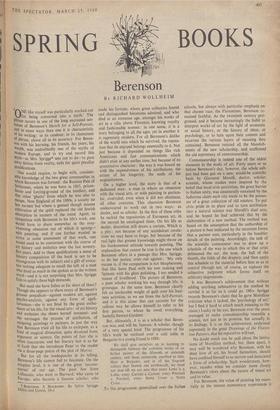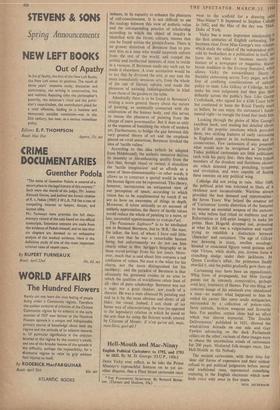SPRING BOOKS
Berenson
BY RICHARD WOLLHEIM Y\ NE like myself was particularly marked out \Jfor being converted into a myth.' The Phrase occurs in one of the long encrusted sen- tences of Berenson's Sketch for a Self-Portrait, and in more ways than one it is characteristic of his Writing: in its candour, in its clumsiness of phrase, above all in its accuracy. For Beren- son with his learning, his friends, his years, his Wealth, was undoubtedly one of the myths of modern Europe, and to try and record this nlYth—as Mrs. Sprigge* sets out to do—to pare away fiction from reality, calls for quite peculiar qualifications.
One would require, to begin with, consider- able knowledge of the two great communities in Which Berenson was formed: the Russian Pale of Settlement, where he was born in 1865, prison- house and forcing-ground of the intellect, and that other 'ghetto' from which he was also to escape, New England of the 1880s, a society no less earnest but where a genteel though intense Cultivation of the spirit replaced the old Jewish absorption in matters of the mind. Again, to sYmpathise with Berenson in his life's work, one Would have to share somewhat in the over- whelming obsession out of which it sprang— with painting; and if one further wanted to arrive at some assessment of that work, one would need to be conversant with the course of art history and wsthetics over the last seventy- live years. Add to these qualifications a sense of literary composition (if the book is not to be incongruous with its subject) and a gift of evoca- tive writing adequate to recall the talk of a man Who lived as much in the spoken as in the written word—and it is not surprising that Mrs. Sprigge fails to satisfy these high demands.
But need she have fallen so far short of them? Though she appears to share many of Berenson's grosser prejudices—against modern art, against PsYcho-analysis, against any form of egali- tarianism—she is not fired by the great enthu- siasm of his life, for the visual arts: of art history and esthetics she shows herself innocent: and She envisages the process of attribution, of assigning paintings to painters, in just the way that Berenson tried all his life to extirpate, as a kind of magical divination, quite divorced from argument or science. Op points of fact she is Often inaccurate, and her literary tact is so far at fault that she introduces Pater to the reader via a three-page prdcis of the plot of Marius.
But for all the inadequacies in its telling, Berenson's life cannot fail to fascinate. On the simplest level, it is one of the great 'success- stories' of our age. The poor Jew from Lithuania; who went to Harvard; who came to Europe; who became a famous scholar; who
* BERENSON. A BIOGRAPHY. By Sylvia Sprigge. (Allen and Unwin, 35s.)
made his fortune; whom great collectors feared and distinguished historians admired; and who died at an immense age, amongst his works of art in a villa above Florence, knowing royalty and fashionable women : in one sense, it is a story belonging to all the ages, yet in another it is supremely modern. For all Berenson's dislike of the world into which he survived, the reputa- tion that he enjoyed belongs essentially to it. Not just because it depended on things like rich Americans and fast communications which didn't exist at any earlier time, but because of its quantitative character: the way it was bound up with the expensiveness of his attributions, the extent of his longevity, the scale of his acquaintances.
On a higher level, the story is that of a dedicated man: a man in whom an obsession with the visual arts, or with painting in particu- lar, overruled, even when it did not eliminate, all other concerns. This obsession Berenson endeavoured to work out in two ways: as dealer, and as scholar. In the first of these roles he sacked the repositories of European art, in the second he catalogued them. On his life as dealer, discretion still draws a curtain. Which is a pity : not because of any scandalous revela- tions we may have to forgo, but because of the real light that greater knowledge might throw on his fundamental attitude towards painting. The explanation that cannot be true is the one which Berenson offers in a passage that Mrs. Sprigge, to do her justice, cries out against : 'My only excuse is, if the comparison is not blasphemous, that like Saint Paul with his tent making and Spinoza with his glass polishing, I too needed a means of livelihood: The picture of Berenson, a poor scholar working his way through life, is grotesque. At the same time, Berenson clearly felt an intolerable weight of guilt over his busi- ness activities, as we see from the Self-Portrait, and it is this alone that can account for the callous way he allows himself to refer to his first patron, to whom he owed everything, Isabella Stewart Gardner.
But, ultimately, it is as a scholar that Beren- son was, and will be, famous. A scholar, though of a very special kind. The programme of his life's work he outlined over a cafd table in Bergamo to a young friend in 1889:
We shall give ourselves up to learning to distinguish between the authentic works of an
Italian painter of the fifteenth or sixteenth
century, and those commonly ascribed to him. Here at Bergamo, and in all the fragrant valleys that branch out northwards, we must not stop till we are sure that every Lotto is a Lotto, every Cariani a Cariani, every Previtali a Previtali, every Santa Croce a Santa Croce. . • .
To this programme, generalised over the Italian schools, but always with particular emphasis on that chosen race, the Florentines, Berenson re- mained faithful. As the twentieth century pro- gressed, and it became increasingly the habit to interpret works of art by the light of economic or social history, or the history of ideas, or psychology, or to turn upon their content and excavate the various layers of meaning they contained, Berenson resisted all the blandish- ments of the new scholarship, and reaffirmed the old supremacy of connoisseurship.
Connoisseurship is indeed one of the oldest elements in the study of art. Forty years or so before Berenson's day, however, the whole sub- ject had been put on a new, would-be scientific basis by Giovanni Morelli, doctor, scholar, scientist, whose studies were inspired by the belief that local civic patriotism, the great barrier to Italian unity, was unnaturally sustained by the ludicrous claim each city made to be the posses- sor of a great collection of old masters. To put civic pride in its place and to turn attribution into a natural science was Morelli's dual aim, and he hoped he had achieved this by the elaboration of a new method. The method was based on the assumption that the authorship of a picture is best indicated by the recurrent forms that a painter uses, particularly in the humbler details of the painting. Accordingly, the task of the scientific connoisseur was to draw up a schedule of the way in which this or that artist delineated the ear, the nose, the ball of the thumb, the folds of the drapery, and then apply this schedule to the material before him so as to control (though not, of course, to replace) the subjective judgment which forms itself on arbitrary impressions.
It was Berenson's achievement that without adding anything substantive to the method he carried it as far as it could go. (Mrs. Sprigge records Berenson's claim that he gave Morellian criticism what it lacked, the 'psychology of art,' but I find it hard to attach much meaning to the claim.) Lucky in his eye, Berenson over the years managed to make connoisseurship resemble a
science, not just in its promise, but actually in its findings. It is on this achievement, enshrined supremely in the great Drawings of the Floren- tine Painters, that his reputation will rest.
No doubt much can be said about the limita- tions of' Morellian method, but, these apart, it may well be wondered why Berenson, with his deep love of art, his broad humanism, should have confined himself to so narrow and desiccated a form of scholarship. Such wonderment, how- ever, recedes when we consider more closely Berenson's views about the nature of visual art and its value.
For Berenson, the value of painting lay essen- tially in the intense momentary experiences it induces, in its capacity to enhance the pleasures of self-consciousness. It is not difficult to see the analogy between this view of ;esthetic value and the corresponding practice of. scholarship according to which the object of inquiry is identified with the forms, colours, themes that can be found within the picture-frame. There is no grosser distortion of Berenson than to pre- sent him as a man who would amputate culture from the rest of the world, and compel the artistic and intellectual interests of man to reside in a vacuum. If Berenson made any such cut, he made it elsewhere. A truer accusation would be to say that he divorced the arts, at any rate the more immediately sensuous arts, from the whole of the rest of human culture, and made the pleasures of painting indistinguishable in kind from those of the garden or the table.
Admittedly there is to be found in Berenson's writing a more general theory about the nature of painting, as essentially connected with the celebration of the human body, and this serves to rescue the pleasures of painting from the charge of mere gourmandise. But it does so only at the expense of banishing the whole of modern art. Furthermore, to bridge the gap between this very general theory of art and the emphasis placed on vivid sensations, Berenson invoked the idea of 'tactile values.'
According to this idea (which he adapted from Hildebrand), the ;esthetic sensation derives its intensity or life-enhancing quality from the fact that, though visual or retinal, it stimulates the 'tactile imagination' and so affords us a sense of three-dimensionality--in other words, it allows us to construct a spatial world in which the human figure can be represented. This theory, however, incorporates an antiquated view of our perception of space, according to which vision has to be supplemented by touch if we are to have an awareness of things in depth. Moreover, if taken seriously as an account of esthetic appreciation, the theory of tactile values would reduce the whole of painting to a more, or less, successful approximation to trompe-rceil.
The Passionate Sightseer* is to be' attributed not to Bernard Berenson, but to `B.B.,' the man, the talker, the host, of whom I have said little. I am sure that he was a remarkable human being, but unfortunately we do not see him clearly either in Mrs. Sprigge's biography or in these travel-jottings from his last years. More- over, much that is said about him contains a sad confusion of values. No man is the wiser for his charm, nor the more distinguished for his snobbery: and the paradox of Berenson is that ultimately his greatness resides in an area to which the qualities of worldliness relate least of all—that of pure scholarship. Berenson was not a sage, nor a great thinker; nor much of a theorist. He was a man obsessed by painting and tied to it by the most obvious and direct of all links: the visual. Indeed, I can think of no better way of characterising the true (as opposed to the legendary) relation in which he stood to the arts than by using the famous words uttered by Cdzanne of Monet : 11 West (p.m? (ell, trials, mon Dieu, quel all



















































 Previous page
Previous page